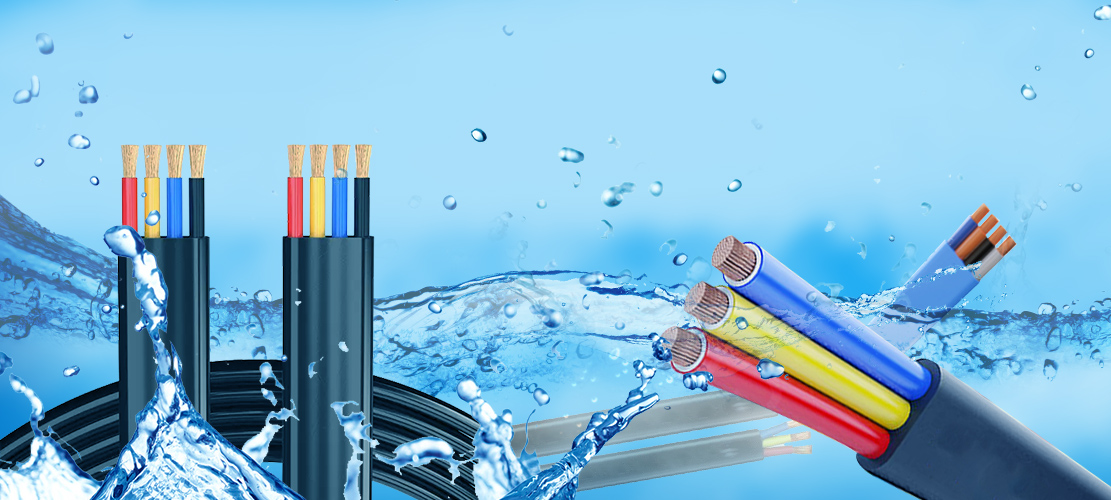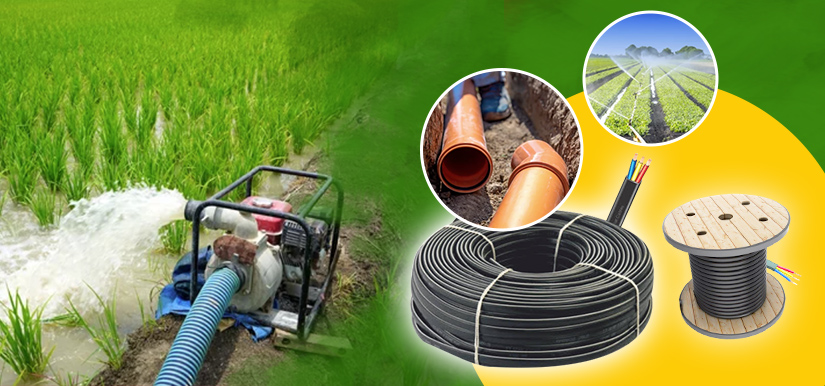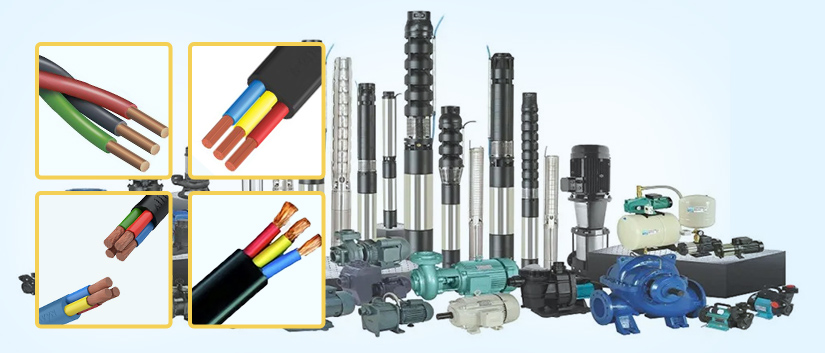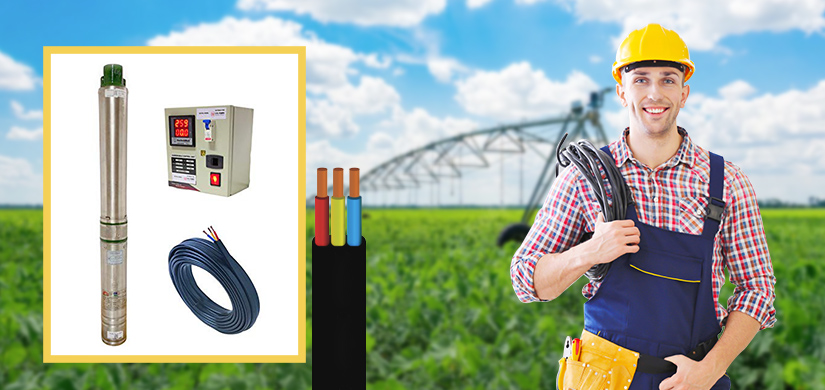
Submersible Cables as A Special Purpose Cable
Electricity transmission in submerged equipment, motors, and other underwater conditions requires a specialized cable. Submersible cables, specially designed cables, operate underwater for electricity transmission without any interference or failure.
Submersible cables are safe, reliable, fire retardant, fire resistant, lead-free, and non-toxic to support a range of industries and sectors. Chemical and abrasion resistance properties of submersible cables make their application in food processing, water treatment, mining, swimming pool lightning, aquariums, system processing, and preserving food and drink for human consumption. These cables are suitable for depths of up to 10 to 800 meters.
Gloster Cables designs and manufactures submersible cables of different shapes and sizes to meet their application in various industries, sectors, and submerged environments.
About Submersible Cables

Submersible cables are special-purpose cables that supply power to machinery and equipment operating in submerged environments, such as pumps, irrigation, and drainage equipment. And are specially designed to work flawlessly in various water conditions, like fresh water, salt water, brackish water, oils, syrups, etc. And protect from all kinds of adverse environmental conditions.
Submersible cables have the power to withstand humid and wet conditions for a long period with their robust structure and strong- electrical and mechanical properties. The waterproof property of these cables helps them operate underwater for a prolonged period and withstand pressure. Submersible cables offer robust performance underwater from very shallow to depths of up to 800m,
The design enables these cables to work effectively in hostile and demanding work environments, offering- high safety and reliability. The rubber and plastic coating make these cables easy to withstand any environment type. These cables support a range of industries, from food processing to water treatment, where improved chemical and abrasion resistance is required.
Characteristics and Conductors Used for Submersible Cables
Submersible cable is a versatile product featuring an extra flexible construction. A few characteristics of submersible cables that make their application in various adverse conditions are listed down.
Waterproof and Moisture Resistance
AD protection against water establishes to what extent an electrical cable can get exposed to moisture, as per UNE 20460-3:1996 standard. Submersible cables are AD8 protected, ensuring water or humidity do not degrade the cable’s performance.
Abrasion Resistance
The abrasion resistance feature of the submersible cable limits the possibility of exposing the inner core of the cable, as a result of wear and tear during its installation or live operations.
Good Electricity Conductivity
Good electrical conductivity ensures efficient transmission of electricity through the cable, guaranteeing the robust performance of the submerged equipment.
Excellent Insulation
As these cables operate underground or in any submerged environment, it is essential to have excellent insulation. It increases the cable life and delivers good performance through its rated life.
High-temperature Resistance
A submersible pump working in high-temperature needs submersible cables that are high-temperature resistive to support the pump.
Conductors Used for Submersible Cables
Submersible cables get mainly produced from electrolytic copper of superior quality. The conductors have PVC compound insulation, and the outer covering has an abrasion-resistant PVC compound.
The cables' efficiency and performance in different projects, depend on the type of conductor used. Copper is the most preferred and widely used alloy as a conductor for submersible cables. And the reason for using copper alloy as a conductor for submersible environments are

The high-conductivity rating of copper makes it a good conductor.

Copper is a flexible and malleable material. It makes copper easily bend and turn during submerged installations.

Copper is naturally resistant to heat and high temperatures. Submersible cable manufacturer prefers it as the conductor as it prevents overloading issues.
Different Types of Submersible Cables and their Applications

The main application of submersible cables is to run submersible pumps and motors appropriately. Submersible pump wires and cables are available in PVC or EPR insulation. These cables are UL-listed Type THW submersible cables. Different submersible pump cables available are twisted-pair copper cables, flat cables, round cables, and heavy-duty cables.
Twisted-Pair Cables
Submersible pump twisted pair cables are suitable for typical light-duty pump applications. These cables do not have extra protection, and the cost range is low and more affordable than the other cables. Twisted copper cable is best to use when the well is shallow, as the maintenance of the wire and its repair and replacement will cost low.
Flat Cables
Flat submersible pump cables have PVC insulation, giving extra protection from abrasion and mechanical impact. These cables have two conductors and a ground wire. These cables provide durability for submersible pump applications. Flat cable jacketing protects from getting the cable wear-off due to rubbing against the surface in deep wells.
Flat submersible cables fit the standard design of a submersible pump and supply the water to most submersible pumps, where a two-conductor construction gets required. Flat rubber cables are the perfect choice for supporting pumps and other devices submerged at 500 meters depth or more. These cables are easier to install if the diameter of the well is significant and are less prone to wearing off during installation.
Flat cables are very-costly than twisted copper cables and are comparable to round and heavy-duty cables.
Round Cables
Round cables consist of three conductors and a ground wire. These cables are preferable where submersible pump application requires three-conductor construction, with some large submersible well construction. They are ideal for sewerage and wastewater treatment pumps and where there’s high acidity.
In comparison to unjacketed twisted pair cables, flat cables are more durable. However, these cables are not as durable as flat cables as the conductors are not in a non-parallel way like flat cables.
Heavy-duty Cables
Flat cables having an extra rating for heavy-duty use are known as heavy-duty cables. These cables have double-jacketing, providing added protection in adverse conditions. Heavy-duty cables are ideal for submersible pumps in extreme conditions.
Applications of Submersible Cables
Submersibles get designed and manufactured to work underwater without any interruption. They feature an extra flexible construction and are flame-retardant and waterproof. These cables are highly durable, reliable, safe to use, take a heavy load, and are versatile, making them suitable for application in several industries and sectors. Some specific applications of submersible cables are
These cables work well when there is a requirement for transmitting electricity to and from submerged electrical equipment.
Select a Submersible Cable Based on Your Project Application and Requirement

Submersible cables offer various advantages, such as durability, versatility, safety, and reliability. They are available in different shapes and sizes, and their selection depends on your requirement and project.
Gloster Cables, a leading wire and cable manufacturer, offers round and flat submersible cables of different sizes and shapes. And Colour coding of these cables makes them ideal for identification. Gloster’s submersible cables are ISI 694 marked, FIA/TAC approved, and follow different testing standards. It enables these submersible cables effectively perform underwater and in various submersible conditions.
CONTACT US